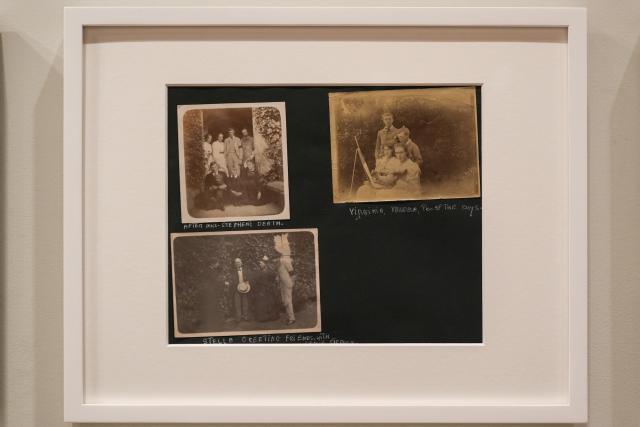
Photograph album pages
Transcript below
Francesca Wade: It’s very moving to see these, particularly knowing, I guess, the family history, and Stella and her mother died probably pretty soon after these pictures were taken. And I think the kind of idyllic family life that Woolf often kind of harks back to, which got totally changed after her mother and Stella’s and then her father’s deaths, is really evident in these pictures.
Brandon Taylor: Yeah, there’s something so dreamlike about them and so ethereal and haunting. A thing that I also am struck by is people had not been taking pictures for very long when these were taken, and it seems that the poses that they’ve landed on are poses that we still use today. They look so familiar and so haunting, and so it’s strange to think about. By this point, we hadn’t been living with the idea of an exact visual memory of events for very long, and to think about Virginia Woolf, who of course becomes one of the great writers of memory and the difficulty of memory, I find that also very delightful that she had this incredibly well documented childhood.
Francesca Wade: I don’t know how often she kind of looked back over family photos. I mean, in her… In 1939 and 1940, during the Second World War, she was really turning back in her mind back to her childhood and thinking her way through her life, kind of through the different houses that she’d lived in, right back to to Talland House and Hyde Park Gate, which would be the site of a lot of these photos. But I don’t know how much she used photos as a kind of visual reminder because these would, I would have thought, provoke a lot of memories, perhaps ones she might like to forget.
Brandon Taylor: I mean, that’s the other aspect to it, right, is, you know, these are pictures from private family albums. These are sort of private family memories, and for us as the viewer, we have our own feelings about them as artifacts, literary artifacts. But there is this whole other element in which they belong to a family, and they document these particular family moments, and it’s interesting to think about all the things that we don’t see. Although, was there a squabble to get little Virginia to pose for this photo, and this gorgeous picture of her mother?
Francesca Wade: It’s amazing to see the pictures—you can just make out the sort of arrangement on the wall. She writes a lot about the feeling kind of hemmed in by the cigar-infused furniture and the mahogany walls and the ivy kind of creeping up and blocking out the windows, and how she longed for kind of open air and white walls and photographs rather than old portraits. I think when they moved to Bloomsbury, they decorated their wall with photographs taken by her aunt Julia Margaret Cameron, who was one of the very earliest photographers actually, which might explain the Stephen family’s early uptake of the medium.
End of Transcript